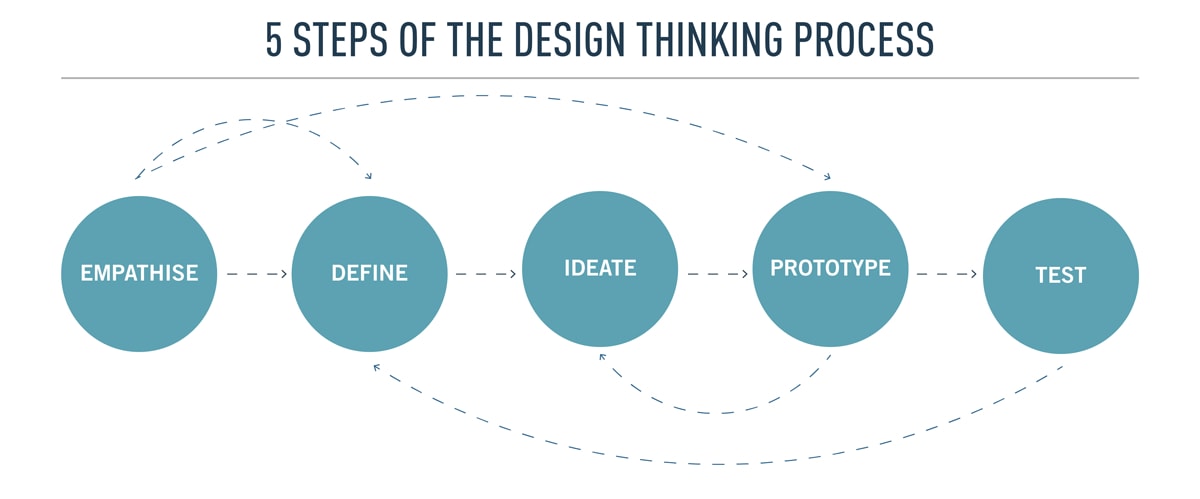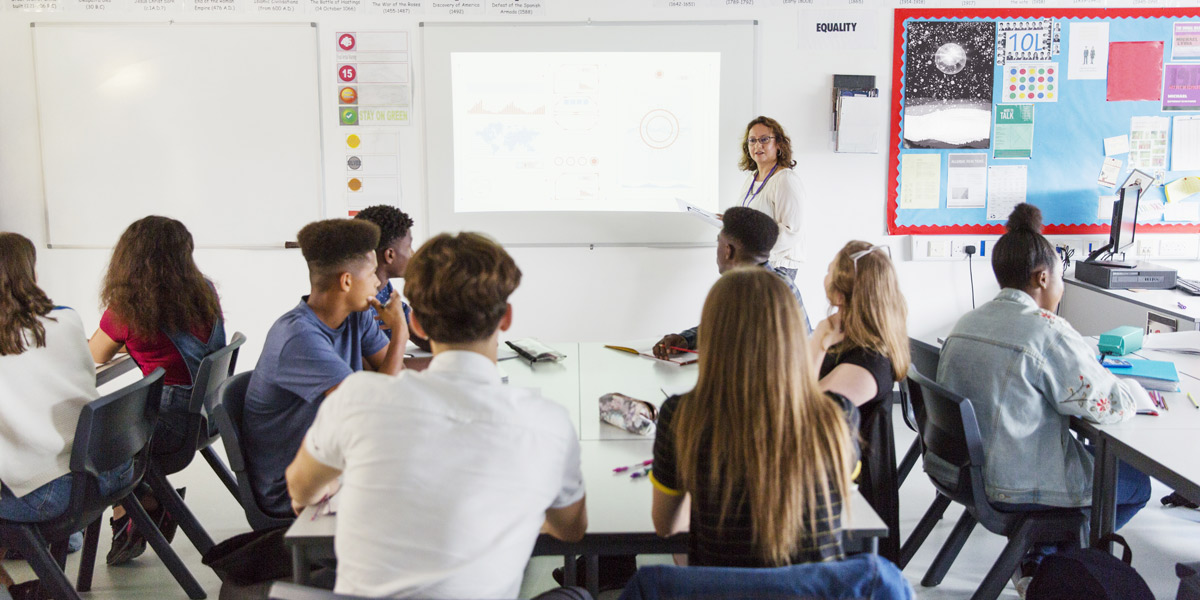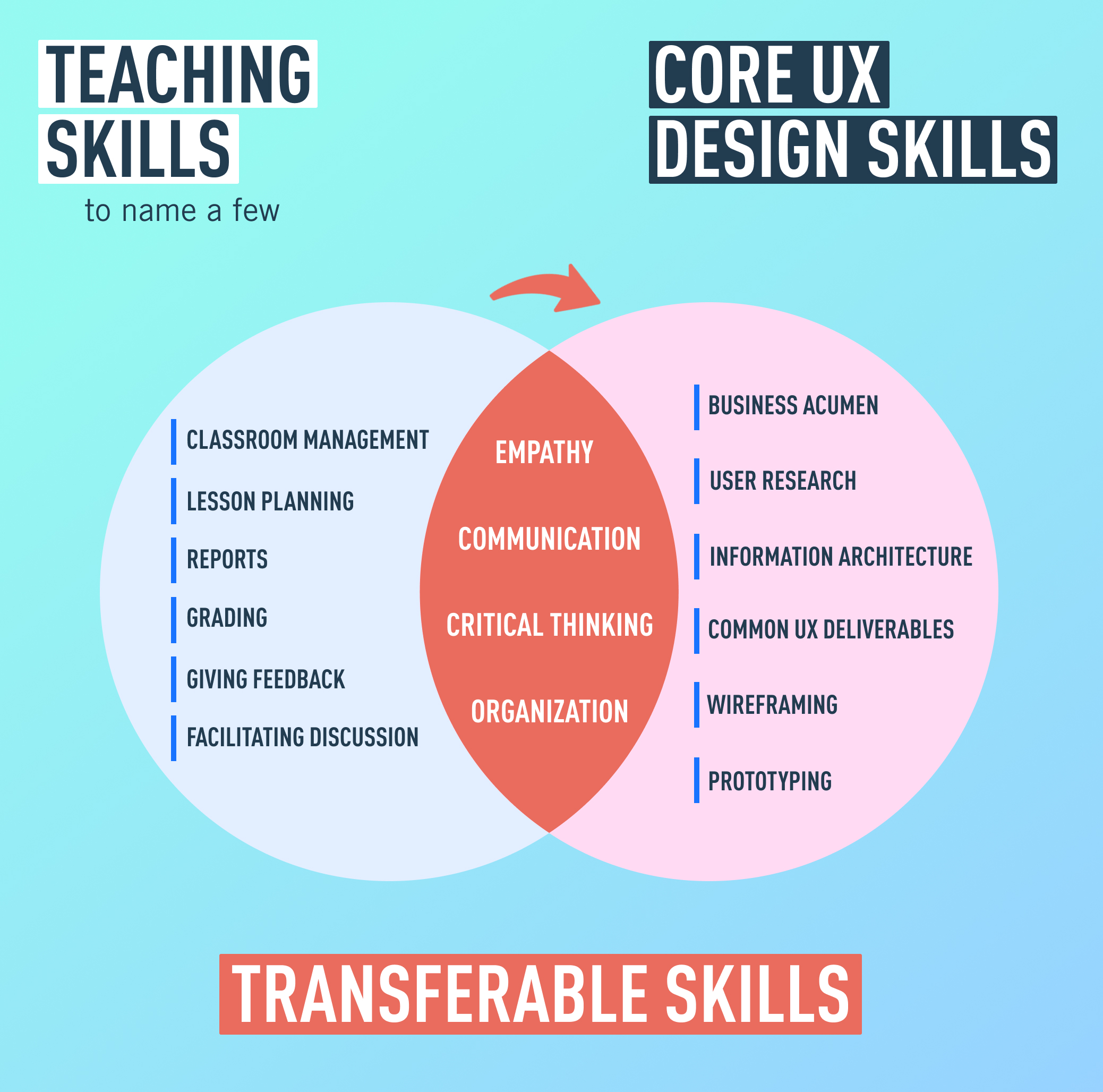If you’ve got a background in teaching (at any level!), but you’re looking to forge a new professional path, UX design could be just the direction you’re looking for—and the skills that make you such an amazing educator could very likely give you a head start!
Some of the very things that draw people to work in the education field find expression in the creative and dynamic field of UX design.
But the prospect of leaving education and breaking into tech? That can be daunting. It’s important first understand that there’s no one right career path into or through UX design. Once you understand that, just have a look around before you take the leap—to know just what you’re getting into (both the challenges and the rewards). This guide will give you a clearer idea of what that transition might look like.
We’ll cover what exactly UX design is, the skills you’ll need to break into the field, which skills you may already have, and how to bridge the gap. We’ll even share a few stories of others who have successfully switched from teaching to UX design!
Here’s what we’ll cover:
- What exactly is UX design?
- Salaries: Teaching vs. UX design
- Teaching to UX: What are my transferable skills?
- What skills will I need as a UX designer?
- The learning curve: How do I learn UX design?
- Success stories: Teachers turned UX designers
- Closing thoughts
1. What exactly is UX design?
Let’s start from the very beginning. It’s simple enough and clear by its name: UX design—short for user experience design—is the design of experiences for users.
But what is user experience? User experience is how a user feels as they engage with your product. It is the summation of what causes them to come to your product in the first place, what they do to accomplish what they came there for, what they encounter along the way, and how they respond to any one moment in that journey—or how they feel about the journey as a whole.
So, UX design is the process of creating products and experiences that help users meet a specific need or goal. It’s the collaborative, creative, and dynamic work of making products and experience as efficient and effective as possible. More and more, UX design is also about ensuring that products and experiences are usable, accessible, and inclusive—and, when possible, delightful.
Similar to what a teacher does when they connect with students, find ways to engage them and ensure they’re learning what they need to learn, UX designers connect with users, find out what they really want and need, identify pain points (places along the way that don’t go as well as they could or cause users to give up or drop out of a process), and find ways to resolve those pain points, enhance the user experience, and help user accomplish what they’ve come there to do.
UX designers wield the full power of design thinking as they go about the design process:

The process begins by connecting with users and understanding what makes them tick, as well as what they really need from this product or experience. That’s called user research and it comprises the bulk of the empathize stage of the process.
The next step is to clearly define what problems, needs, and goals users have that the product could potentially solve or help users achieve. This leads naturally into the ideation stage, when UX designers actively come up with feasible solutions to the problems they’ve defined. This ideation can take many forms, but it’s not unlike brainstorming ideas for classes, projects, and lesson plans.
In the prototyping stage, UX designers take their solutions and build them into a functioning model so they can share the ideas with stakeholders and test the solutions to make sure they’ll actually work. And that’s the final stage of the process: testing and making sure that the solutions they’ve arrived at will actually improve the user experience.
UX designers iterate on their designs through this process, all the while working with stakeholders and others in the company who will help turn the designs into a fully functional product—UI designers, data analysts, and web developers and others.
If you’d like to learn more about what UX design actually is, check out CareerFoundry’s UX design guide—it gives a great overview of the field and defines some of the key aspects of the job and its value in the world of product development. And if examples help you get a sense of things, here are five examples of UX design gone right.
2. Salaries: Teaching vs. UX design
Before we get into your skillset and how it’ll transfer into UX, let’s dig into one of the most practical considerations of a career change: salary. However you feel about money or how much you’re making now, it’s important to have some idea of what your salary might be if you do change careers.
While it’s not always the case that teachers are underpaid, it’s safe to say that many educators who spend most of their time in the classroom or lecture hall could do with a raise. If you’re looking to switch to UX design, the good news is that you won’t need years of experience in the field before you’re likely to see an increase in your income.
According to Adobe’s hiring trends report, the demand for UX designers has overtaken demand for graphic designers, with 11% more managers placing UX designers as their top hiring priority (tied with software engineers). This bodes well for aspiring UX designers!
As more and more companies embrace the business value of UX design, the value of this role increases. Here’s a breakdown of the average salaries for UX designers and graphic designers in several major countries. Bear in mind that while the overall difference in salaries is clear, there are always variations dependent on location, organization, and your particular areas of expertise.
If your teaching experience is primarily outside of the K-12 (primary, secondary, or high school) environment, there is also broad variation based on what level your position is in the school or organization and how much experience you’ve got.
For example, if you work(ed) in adult basic education in the United States, your salary might land anywhere between minimum wage and $46,000/year—or higher if the program is embedded in a university with an administrative position. If your experience is mainly in a college or university setting, you know better than anyone how much salaries can vary based on the type of contract you hold.
Average salaries by country
Canada
Average salary for a UX designer: CA$72,000
Average salary for a K-12 teacher: CA$68,321
Australia
Average salary for a UX designer: AU$90,000
Average salary for a K-12 teacher: AU$71,517
Germany
Average salary for a UX designer: €51,000
Average salary for a K-12 teacher: €40,614
China
Average salary for a UX designer: ¥204,000
Average salary for a K-12 teacher: ¥260,500
United Kingdom
Average salary for a UX designer: £40,166
Average salary for a K-12 teacher: £30,524
United States
Average salary for a UX designer: $85,000 USD
Average salary for a K-12 teacher: $49,624 USD
3. Teaching to UX: What are my transferable skills?

Now that you’ve got an idea of what UX designers do and the average salary they earn, let’s talk skills. The best place to start is close to home: What skills do you already have that will transfer well into a career in UX design?
Empathy
One of the most important skills to succeed in UX design: empathy. The business and strategic sides of things are certainly an important factor, but there are usually plenty of people in a company who can provide insight on those priorities; technical skills do matter a great deal; but these are skills that can be learned. What’s more difficult to learn is how to really connect with users, to observe them, and to understand their needs and goals, what motivates them, what frustrates them—and how to advocate for them when they’re not around.
Many teachers are drawn to this profession by the connections and relationships they can build with their students. Chances are that if you’ve got even just a year of teaching experience under your belt, you have stories and memories of those really great students who were really engaged—or the “problem” students who took a little more intention and care to connect with. This is empathy. And you’ll need this skill as a UX designer.
You have experience in observing how your students learn, and adapting your teaching style or curriculum to what will best help them learn. You have experience in communicating with their parents or advisors (or sometimes the students themselves) about their needs, their progress, and their successes. You probably even have experience in advocating for the needs of your students in meetings—with parents and administrators.
UX is all about connecting with and advocating for the needs of the people who will use your products. As a teacher (current or former), you probably already have this down pat.
Communication
UX designers are constantly in communication with other designers, developers, writers, team leads, directors, and even CEOs—in addition to working directly with users during research and testing. If a UX designer can’t communicate well, they’re not likely to get far.
The good news for you is that your teaching experience has given you time and opportunity to put the proverbial pedal to the metal in fine-tuning your communication skills.
Most teachers are adept at communicating with students (each with their own communication needs), parents, and administrators. If you’ve had any success in a classroom of students at any level of education, chances are high that you know how to read a room. You know when your ideas are coming across clearly, and how to check in and make sure your students are understanding as you go along. You also know how to vary and adapt your approach to get better or different results.
So put communication on the list of skills you probably already have and can bring with you into your UX design career.
Organization
As a teacher, you’ve got experience in keeping yourself and your teaching materials and records organized. Between meetings and classes, lesson plans, preparation, grading, reports, and paperwork, if you’re not a master at organization, you at least understand how to get things done and reduce chaos. And that’s a good thing, because you’ll need this skill as a UX designer.
If it hasn’t already become clear, we’ll say it plainly: UX designers do a lot of different things with a lot of different people, and usually those things aren’t happening just one at a time. There’s overlap between projects and tasks, there are certainly deadlines to meet, and sometimes there’s pressure to get a lot done in a day’s time. All that to say that organization will be a skill that you, your colleagues, and your users will be grateful you’ve got in hand.
Critical thinking
A big part of the job UX designers do relates to user research: planning it, conducting it, and distilling the results into actual understandable and applicable insights that can be turned into actionable ideas that solve design problems.
This takes a great deal of critical thinking. They’ve got to be able to take a deep dive into what users say and do, what they want and need and to translate this qualitative data into actionable insights—and to show stakeholders the connections between the research data, the design solutions, and the business goals. This is another skill that critical to have and difficult to learn.
Thankfully, this is yet another skill that you’ve practiced regularly as an educator. From observing your students and formulating new and better ways to teach them to explaining your approach and results to parents and colleagues, you know how to analyze, evaluate, and communicate your observations.
4. What skills will I need as a UX designer?
Because the role of a UX designer is simultaneously strategic, collaborative, empathetic, and technical, the skill set you’ll need is incredibly varied. Here, CareerFoundry mentor Tobias gives a 5-minute overview of the essential UX design skills:
As Tobias points out, it’s all too easy to get carried away with getting those hard skills under your belt and forget about the softer skills that are just as essential to your success.
By now, you already know that empathy, communication, organization, and critical thinking are four of the most important competencies UX designers need. There are a lot of other non-design skills that UXers need to master—including competencies in business, fianance, psychology, and networking.
Beyond these competencies, though, there are many technical skills you’ll need to develop. Let’s have a look at what some of those are.
Information architecture
Successful UX designers also cultivate mastery of the art and science of information architecture. Information architecture is the science of organizing and structuring content in such a way that the arrangement of the content itself helps users accomplish what they came to the product for. A good UX designer has a clear understanding of what good information architecture looks like and can spot areas for improvement in a product’s design.
User research
Good UX designers know how to connect with users, what kinds of questions to ask, and the types of observations to make as they gather data. As a UX designer you’ll interact directly with users as you go about the user research stage of the design process—yet another critical skill in the world of UX. You might call this the heart of the job! This skill alone is a combination of a variety of soft and hard skills—like communication (soft) and creating a research plan (hard).
Common UX deliverables
UX designers also know how to take the data they uncover in their research and distill it into clear deliverables and actionable insights. This is a broad and varied set of skills that will include everything from critical thinking and problem solving to understanding the function and makeup of key deliverables—such as an affinity map, a user persona, a customer journey map, or a user flow—and how to create those deliverables through the efficient use of industry standard tools. Here are our complete guides on how to create these artifacts:
- 5 Steps to build your first user persona
- How to create a customer journey map
- How to create a user flow
Wireframing and prototyping
And finally, speaking of industry standard tools, UX designers have a solid grasp on how to create low-, mid-, and hi-fidelity wireframes and prototypes. Once designers have landed on the ideas they want to try out to improve the product or experience, they move on to create wireframes and prototypes. Wireframingis the process of creating a digital blueprint of the product with the design changes in place. These blueprints are then used to produce a testable prototype of the product, which is the final step before rolling out that new and improved product.
5. The learning curve: How do I learn UX design?

Let’s pause for just a second and take stock of everything we’ve discussed so far—because that alone will help you to assess where your skillset is and which skills you need to develop. In other words, where will most of your learning need to take place?
As a teacher, you’ve got an existing that includes empathy, communication, organization, and critical thinking—and of everything in a successful UXers skillset, these are arguably the most difficult to learn. You’ll want to make sure these skills are up to snuff, but for the most part, you can check these off your list.
This leaves you with the more technical and UX-specific side of things. While that might seem like a lot, these are the easiest in the skillset to learn and eventually master. So take a deep breath and rest assured—you’re already ahead of the game.
One of your first tasks will be to get better acquainted with design thinking and some key UX processes and deliverables. Luckily, there are a lot of resources out there to help you get started. You can explore the basics by:
- Reading some great UX design books or your pick of design thinking books
- Listening to these UX/UI design podcasts
- Explore free UX design trainings and taking a free short course in UX design
If you’d like a detailed overview of what it takes to be a UX designer, check out CareerFoundry’s free UX Design tutorial.
Next, you’ll need to gain an understanding of some of the industry standard tools—like InVision, Sketch, and Figma. These are staples that you’d do well to master, as well as tools such as Miro, Mural, and any number of user research/usability testing tools and techniques. Get familiar with the most essential tools in UX, common tools for user research, and the best ones for wireframing. Look at it as an exciting way to explore the field and find which tools you like best and want to master!
But remember that you need to go beyond just knowing about these tools to actually applying them. This brings us to one of the most critical elements in changing careers and breaking into UX design: your UX portfolio. We mentioned it before, but it’s worth returning to now just to say that employers are looking to hire candidates who can demonstrate their skillset—not just talk about it. Often, employers want to see you portfolio before they’ll offer so much as a phone screening or an interview.
So be sure you understand the five golden rules of an outstanding UX portfolio and start doing some projects and gathering work you can showcase.
Developing a solid foundation of both knowledge and experience can be a challenge without some structured learning and some expert mentorship. For a deeper dive in the world of UX design—and to really master the art, the craft, and the science—a full certification program is your best bet.
Taking a full course in UX design or earning a certificate in UX design can be one of the most effective ways to jump start your career change. These kinds of learning experiences provide structure, feedback, mentorship, and sometimes even a job guarantee.
Find the right UX certification program and you’ll have found a one-stop shop for learning industry standard tools, mastering key UX processes and deliverables, developing a professional-grade portfolio, and growing into a UX designer that potential employers are eager to hire.
Some—like the CareerFoundry UX Design Program—are fully mentored and even come with a job guarantee to provide some additional feedback, coaching, and assurance as you grow into your new career. They’re also flexible enough to juggle with a full-time job.
6. Success stories: Teachers turned UX designers
If or when you decide that UX design is the right change for your career, you won’t be the first and you won’t be alone. Here are two former teachers who successfully changed careers and are now practicing UX designers:
- Sagan put in a lot of hard work, but managed to start her career in UX over 5 short months. found freedom in starting from scratch. Read about how she found positivity to be a key ingredient in a successful career change.
- Tod taught for eight years before he decided to transition into a career in UX.
While preaching and teaching are not entirely similar fields, there are certainly some crossover skills and experiences! We’re often inspired by Jeff’s story of going from pastoring full-time to working as a UX designer.
And you know the saying: Hindsight is always clearest. Here’s what design experts at AJ&Smart wish they’d known before they became designers.
7. Closing thoughts
Especially for those who went into teaching because they wanted to make a difference in students’ lives—changing careers isn’t always an easy decision. There are so many considerations and possibilities, and some of them are bittersweet. We hope this guide brings some clarity to the process for you and sheds some light on what a transition into UX design might actually look like.
If you’d like to learn more about UX design, or about career change as a whole, check out these articles:
